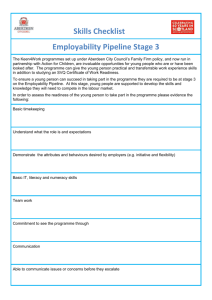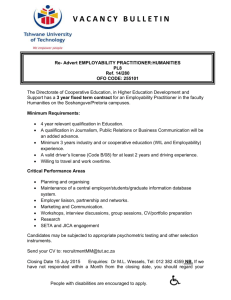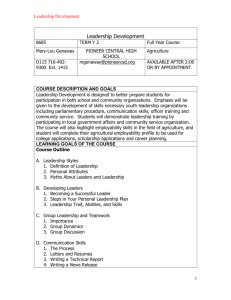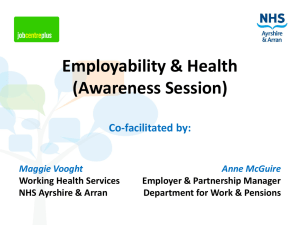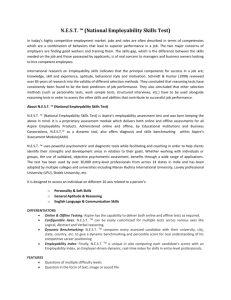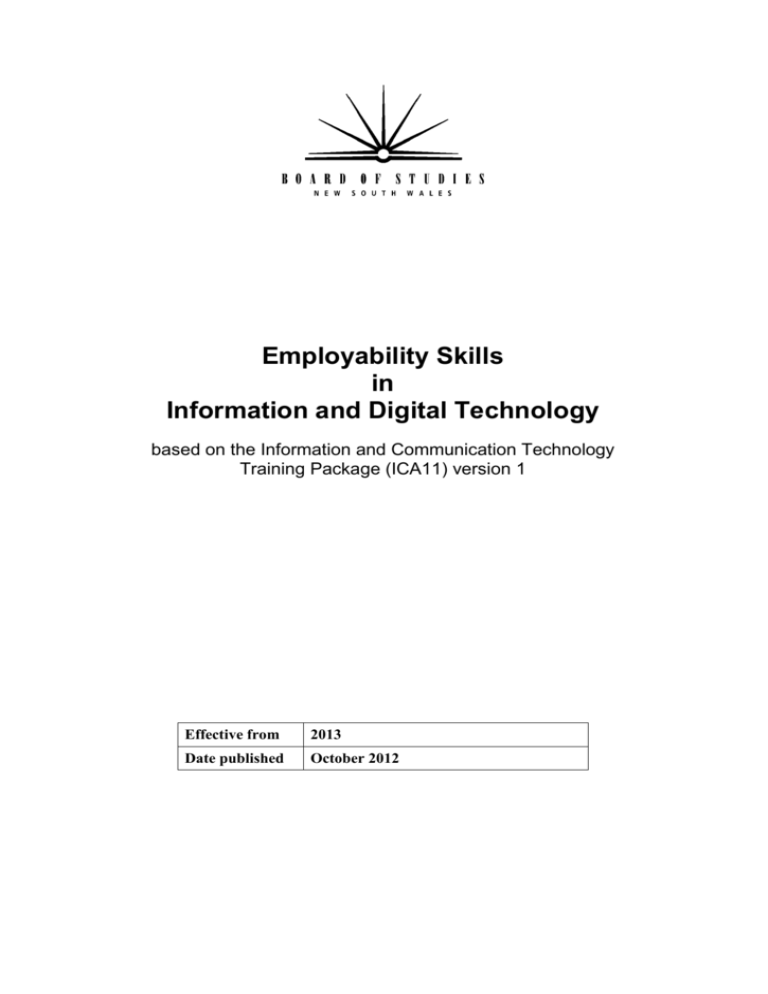
Employability Skills
in
Information and Digital Technology
based on the Information and Communication Technology
Training Package (ICA11) version 1
Effective from
2013
Date published
October 2012
© 2012 Copyright Board of Studies NSW for and on behalf of the Crown in right of the State of New South Wales.
This document contains Material prepared by the Board of Studies NSW for and on behalf of the State of New South Wales.
The Material is protected by Crown copyright.
All rights reserved. No part of the Material may be reproduced in Australia or in any other country by any process, electronic
or otherwise, in any material form or transmitted to any other person or stored electronically in any form without the prior
written permission of the Board of Studies NSW, except as permitted by the Copyright Act 1968. School students in NSW and
teachers in schools in NSW may copy reasonable portions of the Material for the purposes of bona fide research or study.
When you access the Material you agree:
•
to use the Material for information purposes only
•
to reproduce a single copy for personal bona fide study use only and not to reproduce any major extract or the entire
Material without the prior permission of the Board of Studies NSW
•
to acknowledge that the Material is provided by the Board of Studies NSW
•
not to make any charge for providing the Material or any part of the Material to another person or in any way make
commercial use of the Material without the prior written consent of the Board of Studies NSW and payment of the
appropriate copyright fee
•
to include this copyright notice in any copy made
•
not to modify the Material or any part of the Material without the express prior written permission of the Board of
Studies NSW.
The Material may contain third-party copyright materials such as photos, diagrams, quotations, cartoons and artworks. These
materials are protected by Australian and international copyright laws and may not be reproduced or transmitted in any format
without the copyright owner’s specific permission. Unauthorised reproduction, transmission or commercial use of such
copyright materials may result in prosecution.
The Board of Studies has made all reasonable attempts to locate owners of third-party copyright material and invites anyone
from whom permission has not been sought to contact the Copyright Officer, ph (02) 9367 8289, fax (02) 9279 1482.
Acknowledgements
Employability skills summaries from the Information and Communications Technology Training Package (ICA11) in this
document are © Commonwealth of Australia. Reproduced with permission.
The following copyright warning applies to the material from the Training Package:
All rights reserved. This work has been produced initially with the assistance of funding provided by the Commonwealth
Government through DEEWR. This work is copyright, but permission is given to trainers and teachers to make copies by
photocopying or other duplicating processes for use with their own training organisations or in a workplace where the
training is being conducted. This permission does not extend to the making of copies for use outside the immediate
training environment for which they are made, nor the making of copies for hire or resale to third parties. The views
expressed in this version of the work do not necessarily represent the views of DEEWR. DEEWR does not give warranty
nor accept any liability.
Published by Board of Studies NSW
GPO Box 5300
Sydney 2001
Australia
Tel: (02) 9367 8111
Fax: (02) 9367 8484
Internet: www.boardofstudies.nsw.edu.au
20120838
2
Employability Skills in Information and Digital Technology
Contents
Employability Skills in the Information and Digital Technology Curriculum
Framework
Delivery and assessment of Employability Skills
Employability Skills summaries
Employability Skills1 in the Information and Digital Technology
Curriculum Framework
The Employability Skills build on and replace the Mayer Key Competencies (developed in
1992) which attempted to describe generic competencies for effective participation in work.
The Business Council of Australia (BCA) and the Australian Chamber of Commerce and
Industry (ACCI), in consultation with other peak employer bodies, produced the Employability
Skills for the Future report which was officially released in May 2002.
The report indicated that business and industry required a broader range of skills than the
Mayer Key Competencies Framework provided and recommended the following eight
Employability Skills:
communication
teamwork
problem-solving
initiative and enterprise
planning and organising
self-management
learning
technology.
The report described how Employability Skills can be more appropriately described for
particular occupational and industry contexts by sets of ‘facets’ or important work skills.
The following table contains the Employability Skills and facets identified in the report:
Table 1
Employability Skills
Skill
Facets
Aspects of the skill that employers identify as important. The nature
and application of these facets will vary depending on industry and job
type.
Communication that contributes to
productive and harmonious relations
across employees and customers
1
listening and understanding
speaking clearly and directly
writing to the needs of the audience
negotiating responsively
reading independently
empathising
using numeracy effectively
understanding the needs of internal and external customers
persuading effectively
establishing and using networks
Employability Skills is adapted from DEEWR, 2011, Information and Communications Technology Training
Package (ICA11).
3
Employability Skills in Information and Digital Technology
Table 1 cont/d
Skill
Communication cont/d
Teamwork that contributes to
productive working relationships and
outcomes
Facets
being assertive
sharing information
speaking and writing in languages other than English
working across different ages irrespective of gender, race, religion
or political persuasion
working as an individual and as a member of a team
knowing how to define a role as part of the team
applying teamwork to a range of situations, eg planning and
problem-solving
identifying the strengths of team members
coaching and mentoring skills, including giving feedback
Problem-solving that contributes to
productive outcomes
developing creative, innovative and practical solutions
showing independence and initiative in identifying and solving
problems
solving problems in teams
applying a range of strategies to problem-solving
using mathematics, including budgeting and financial
management to solve problems
applying problem-solving strategies across a range of areas
testing assumptions, taking into account the context of data and
circumstances
resolving customer concerns in relation to complex project issues
Initiative and enterprise that
contribute to innovative outcomes
adapting to new situations
developing a strategic, creative and long-term vision
being creative
identifying opportunities not obvious to others
translating ideas into action
generating a range of options
initiating innovative solutions
Planning and organising that
contribute to long and short-term
strategic planning
managing time and priorities – setting timelines, coordinating
tasks for self and with others
being resourceful
taking initiative and making decisions
adapting resource allocations to cope with contingencies
establishing clear project goals and deliverables
allocating people and other resources to tasks
planning the use of resources, including time management
participating in continuous improvement and planning processes
developing a vision and a proactive plan to accompany it
predicting – weighing up risk, evaluating alternatives and
applying evaluation criteria
collecting, analysing and organising information
understanding basic business systems and their relationships
having a personal vision and goals
evaluating and monitoring own performance
having knowledge and confidence in own ideas and visions
articulating own ideas and visions
taking responsibility
Self-management that contributes to
employee satisfaction and growth
4
Employability Skills in Information and Digital Technology
Table 1 cont/d
Skill
Facets
Learning that contributes to ongoing
improvement and expansion in
employee and company operations and
outcomes
managing own learning
contributing to the learning community at the workplace
using a range of mediums to learn – mentoring, peer support and
networking, IT and courses
applying learning to technical issues (eg learning about products)
and people issues (eg interpersonal and cultural aspects of work)
having enthusiasm for ongoing learning
being willing to learn in any setting – on and off the job
being open to new ideas and techniques
being prepared to invest time and effort in learning new skills
acknowledging the need to learn in order to accommodate change
having a range of basic IT skills
applying IT as a management tool
using IT to organise data
being willing to learn new IT skills
having the OHS knowledge to apply technology
having the appropriate physical capacity
Technology that contributes to the
effective carrying out of tasks
There is an Employability Skills Summary for each AQF VET qualification level available in
the Information and Communications Technology Training Package (ICA11). These
summaries capture the key aspects or facets of the Employability Skills that are important to
the job roles covered by the qualification. Summaries are designed to assist trainers and
assessors to identify and include important industry application of Employability Skills in
learning and assessment strategies. The Employability Skills Summaries for the qualifications
available in the Framework are included in this document on page 7.
Employability Skills are essential features of each of the qualifications available in the
Framework and therefore consideration must be given to the ways in which they can be
addressed when designing learning activities and assessment instruments.
It is important for trainers and assessors to know that Employability Skills Summaries:
provide examples of how each skill is applicable to the job roles covered by the
qualification
contain general information which is further explained as measurable outcomes of
performance in the units of competency in each qualification
have varying detail depending on the range of job roles covered by the qualification in
question
are not exhaustive lists of qualification requirements or checklists of performance (which
are separate assessment tools that should be designed by trainers and assessors after
analysis at the unit level)
contain information that may also assist in building learners’ understanding of industry and
workplace expectations.
5
Employability Skills in Information and Digital Technology
Delivery and assessment of Employability Skills2
Employability Skills are integral to workplace competency, and, as such, must be considered
in the design, customisation, delivery and assessment of vocational education and training
programs in an integrated and holistic way, as represented diagrammatically below.
Competency
Standards
Learning
Outcomes
Reflection
Integration
of
Employability
Skills
Workplace
Activities
Assessment
Strategies
Learning
Strategies
Training providers must analyse the Employability Skills information contained in units of
competency in order to design valid and reliable training and assessment strategies. This
analysis includes:
reviewing unit(s) of competency to determine how each relevant Employability Skill is
found and applied within the unit
analysing the Employability Skills Summary for the qualification in which the unit(s)
is/are packaged to help clarify relevant industry/workplace contexts with regard to the
application of Employability Skills at that qualification level
designing learning and assessment activities that address Employability Skills
requirements.
The Department of Education, Science and Training (DEST) developed a resource to assist
trainers and assessors ‘unpack’ the Employability Skills requirements contained in units of
competency and integrate them into training and assessment practice. This resource is titled,
Employability Skills: From Framework to Practice – An Introductory Guide for Trainers and
Assessors.
2
DEEWR, 2011, Information and Communications Technology Training Package (ICA11).
6
Employability Skills in Information and Digital Technology
Employability Skills summary
ICA30111 Certificate III in Information, Digital media and Technology
The following table contains a summary of the employability skills required by industry for
this qualification. The employability skills facets described here are broad industry
requirements that may vary depending on qualification packaging options.
EMPLOYABILITY
SKILL
FACETS ADDRESSED
Industry/enterprise requirements for this qualification include:
Communication
liaising with clients to determine requirements and ensure that they are met
interpreting software manual instructions
producing user documents
Teamwork
contacting operating system vendors to obtain technical specifications and
system requirements
submitting developed user documentation to the target audience for review
Problem-solving
determining the uses and audience of a simple markup language document
troubleshooting and running diagnostic tests and providing solutions to
hardware or software faults
Initiative and
enterprise
assessing and recording information from various sources
identifying and applying skills and knowledge to a wide variety of contexts
investigating and documenting solutions to client problems
customising packaged application software to client requirements
Planning and
organising
planning for the implementation of software changes by seeking technical
and client information and organising the process
Self-management
prioritising and taking responsibility for own outputs in working and
learning
implementing safe and sustainable work practices
Learning
Technology
adopting and transferring skills and knowledge to new environments
keeping up-to-date with current industry-accepted hardware and software
products and services
providing one-to-one instruction for clients about operating system
software
reviewing client feedback and identifying areas for improvement
selecting, installing and using computer software and hardware products
configuring, optimising and testing system software for a small home
office or a small to medium business network
7

